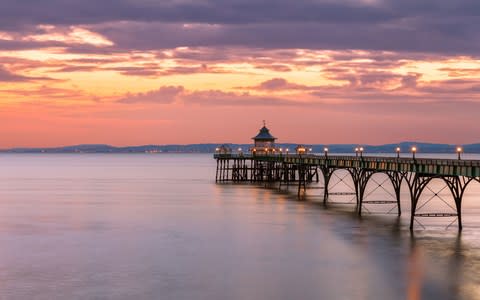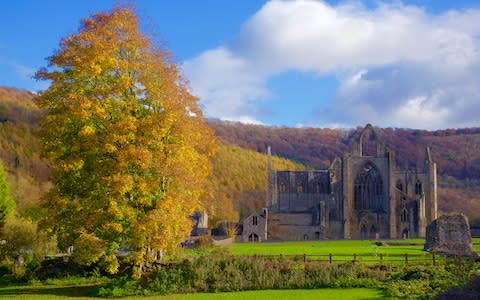Celebrating a toll-free journey: What to do on the Severn Estuary
For more than 50 years, two things put motorists off crossing the Severn Estuary into Wales: the bank of dark clouds likely to be squatting above the Brecon Beacons and the punitive toll charges.
Two bridges span the mudflat-lined estuary – one of the world’s largest tidal ranges. The original Severn suspension bridge, now carrying the M48, was the first to open in 1966. The recently-named Prince of Wales bridge followed in 1996, linking up the M4.
The bridges have always carried tolls but the scrapping of the charges (effective today) is expected to give the Welsh economy a £100m boost.
So now that visitors can cross freely, what might they find at the other end? More than you might think.
England
Flamingo bingo at Slimbridge Wetland Centre
It is not just birds that you can see here – otters make an appearance too. Families will find plenty to do, from learning how to differentiate between the six species of flamingo and various amphibians, to bundling aboard a canoe safari. There is also the watery playground, Welly Boot Land, if kids want to make a splash (wwt.org.uk/wetland-centres/slimbridge).

The pier at Clevedon
With a starkly appealing, Grade I-listed Victorian pier, the coastal town of Clevedon has been growing in popularity recently, partly due to the TV series Broadchurch being filmed here. The pebbled beach is complimented by a large marine lake, which offers good swimming, boating and zorbing. There are also independent boutique shops, pubs with gardens overlooking the sea and one of the world’s longest-running cinemas (visitsomerset.co.uk).
Walking on Brean Down
Having slipped back into the public consciousness recently as the title of a song released by Beak, Brean Down is a rugged headland that bookends the wilder end of Weston-Super-Mare beach at Uphill. It is crowned with a ruined Napoleonic fort and can be reached along a walking trail that offers views of marooned boats, Weston pier and the Bristol Channel (nationaltrust.org.uk/brean-down).
Boat to Steep Holm
This small island sits in the estuary and can be reached, in good weather, by boat from Weston-Super-Mare. Local legend has it that it was formed from earth the devil dug from Cheddar Gorge and hurled into the sea. There was a priory here in the 12th-century. Now you can see 19th-century gun batteries and a barracks-turned-visitor centre (steepholm.org.uk).

Old and new piers at Weston-Super-Mare
An easy hour-long walk takes in Weston’s promenade, woodland and a quiet, natural bay. After visiting the main pier, start along Marine Parade with the sea to your left, continuing around the headland to the crumbling ruin of Birnbeck Pier. Then dip into the woodland paths behind you – with fleeting sea views through the trees – and emerge again at Sand Bay, which you should have mostly to yourself. Take a bus back to the town centre (visit-westonsupermare.com).
Twitching at Bridgwater Bay
“Mud may not look very attractive, but it is rich in microscopic animal and plant life and algae,” says the brochure for the Bridgwater Bay National Nature Reserve, which features mudflats, sand banks and salt marsh. Take binoculars and see how many of the 190 bird species you can spot from the hide (somersetbirding.org.uk/sites/steart-nnr).
Dunster Castle
This picturesque town on the edge of Exmoor has its own beach and a red sandstone castle, set on a small, wooded hill. It was once a Norman fort but was rebuilt as a Jacobean mansion. The engraved, wooden staircase is a highlight indoors while the large and varied gardens, with a working water mill, make for an absorbing wander (nationaltrust.org.uk/dunster-castle).
Wales
Castles and an abbey
Two atmospheric castles can easily be visited in tandem in this part of south Wales. One is the fine Normal castle at Chepstow, which is splendidly sited along a bank close to the mouth of the River Wye. The other is at Caldicot, further along the Severn, an, imposing, typically medieval fortress. When at Chepstow, don’t miss Tintern Abbey – a bit further inland on the Wye – for its large medieval window arches (visitwales.com/explore/south-wales).

Transporter Bridge at Newport
If you crossed the Severn because bridges are your thing, you will already have factored in time to see the transporter bridge at Newport. Built in 1906, it is one of only six operational transporter bridges left in the world. It suspends a gondola – and acts as a kind of aerial ferry – above the River Usk, which feeds into the Severn (newport.gov.uk/heritage).
Hike Offa’s Dyke
Head inland on this classic 177-mile walk that takes in the length of Wales by following the 8th-century English-Welsh border. It starts in Chepstow, before heading to pretty Monmouth (16 miles away), through part of the Wye Valley. It then continues north, skirting the Brecon Beacons (visitwales.com).
Water sports in Cardiff Bay
There are many ways to take to the water in Cardiff Bay, a freshwater lake created at the edge of the estuary by a controversial barrage. These include stand-up paddleboarding, kayaking and white water rafting. The Cardiff International White Water centre has created a number of sports courses on a section of the bay (ciww.com).
On the river
The Severn Bore
It is many surfers’ dream to ride the Severn Bore – a natural tidal phenomenon that pushes upstream. At different times of year, a wall of water created by high tides travels towards Gloucester for more than 25 miles and the Severn’s depth can swell by more than 15 metres. Find the best viewing locations and timings at: severn-bore.co.uk/locations.html.

